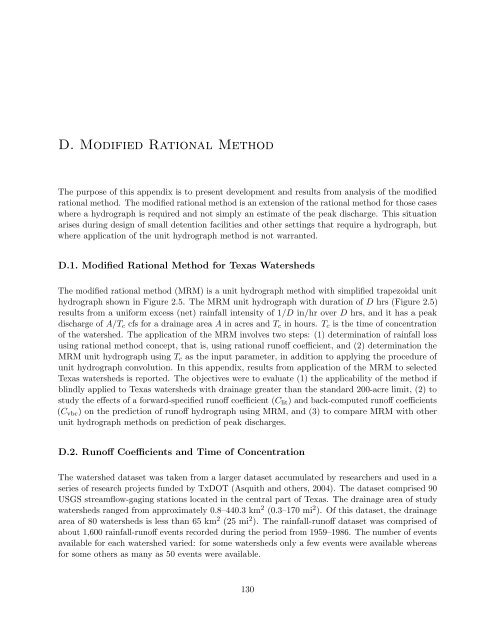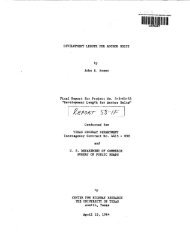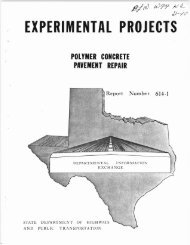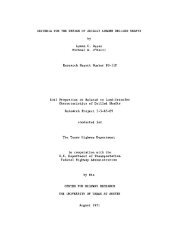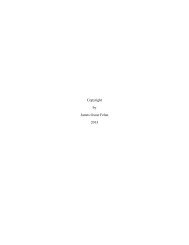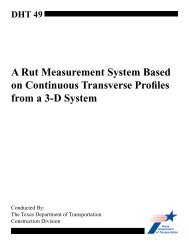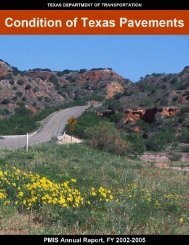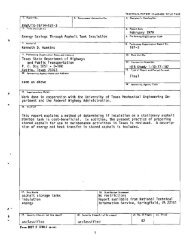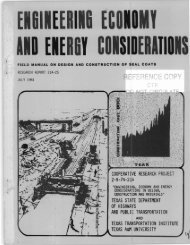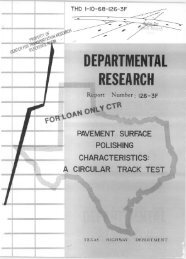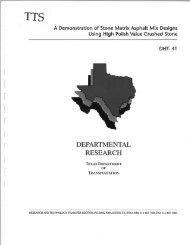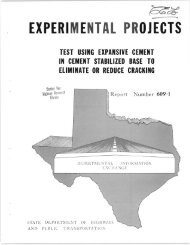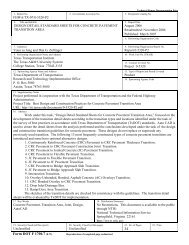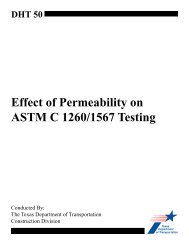Use of Rational and Modified Rational Method for ... - CTR Library
Use of Rational and Modified Rational Method for ... - CTR Library
Use of Rational and Modified Rational Method for ... - CTR Library
Create successful ePaper yourself
Turn your PDF publications into a flip-book with our unique Google optimized e-Paper software.
D. <strong>Modified</strong> <strong>Rational</strong> <strong>Method</strong><br />
The purpose <strong>of</strong> this appendix is to present development <strong>and</strong> results from analysis <strong>of</strong> the modified<br />
rational method. The modified rational method is an extension <strong>of</strong> the rational method <strong>for</strong> those cases<br />
where a hydrograph is required <strong>and</strong> not simply an estimate <strong>of</strong> the peak discharge. This situation<br />
arises during design <strong>of</strong> small detention facilities <strong>and</strong> other settings that require a hydrograph, but<br />
where application <strong>of</strong> the unit hydrograph method is not warranted.<br />
D.1. <strong>Modified</strong> <strong>Rational</strong> <strong>Method</strong> <strong>for</strong> Texas Watersheds<br />
The modified rational method (MRM) is a unit hydrograph method with simplified trapezoidal unit<br />
hydrograph shown in Figure 2.5. The MRM unit hydrograph with duration <strong>of</strong> D hrs (Figure 2.5)<br />
results from a uni<strong>for</strong>m excess (net) rainfall intensity <strong>of</strong> 1/D in/hr over D hrs, <strong>and</strong> it has a peak<br />
discharge <strong>of</strong> A/T c cfs <strong>for</strong> a drainage area A in acres <strong>and</strong> T c in hours. T c is the time <strong>of</strong> concentration<br />
<strong>of</strong> the watershed. The application <strong>of</strong> the MRM involves two steps: (1) determination <strong>of</strong> rainfall loss<br />
using rational method concept, that is, using rational run<strong>of</strong>f coefficient, <strong>and</strong> (2) determination the<br />
MRM unit hydrograph using T c as the input parameter, in addition to applying the procedure <strong>of</strong><br />
unit hydrograph convolution. In this appendix, results from application <strong>of</strong> the MRM to selected<br />
Texas watersheds is reported. The objectives were to evaluate (1) the applicability <strong>of</strong> the method if<br />
blindly applied to Texas watersheds with drainage greater than the st<strong>and</strong>ard 200-acre limit, (2) to<br />
study the effects <strong>of</strong> a <strong>for</strong>ward-specified run<strong>of</strong>f coefficient (C lit ) <strong>and</strong> back-computed run<strong>of</strong>f coefficients<br />
(C vbc ) on the prediction <strong>of</strong> run<strong>of</strong>f hydrograph using MRM, <strong>and</strong> (3) to compare MRM with other<br />
unit hydrograph methods on prediction <strong>of</strong> peak discharges.<br />
D.2. Run<strong>of</strong>f Coefficients <strong>and</strong> Time <strong>of</strong> Concentration<br />
The watershed dataset was taken from a larger dataset accumulated by researchers <strong>and</strong> used in a<br />
series <strong>of</strong> research projects funded by TxDOT (Asquith <strong>and</strong> others, 2004). The dataset comprised 90<br />
USGS streamflow-gaging stations located in the central part <strong>of</strong> Texas. The drainage area <strong>of</strong> study<br />
watersheds ranged from approximately 0.8–440.3 km 2 (0.3–170 mi 2 ). Of this dataset, the drainage<br />
area <strong>of</strong> 80 watersheds is less than 65 km 2 (25 mi 2 ). The rainfall-run<strong>of</strong>f dataset was comprised <strong>of</strong><br />
about 1,600 rainfall-run<strong>of</strong>f events recorded during the period from 1959–1986. The number <strong>of</strong> events<br />
available <strong>for</strong> each watershed varied: <strong>for</strong> some watersheds only a few events were available whereas<br />
<strong>for</strong> some others as many as 50 events were available.<br />
130


